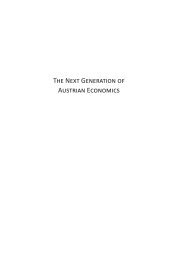capitalist_and_entrepreneur_klein
capitalist_and_entrepreneur_klein
capitalist_and_entrepreneur_klein
Create successful ePaper yourself
Turn your PDF publications into a flip-book with our unique Google optimized e-Paper software.
5<br />
enforcing contracts, <strong>and</strong> so on. Within the firm, the <strong>entrepreneur</strong> may<br />
be able to reduce these “transaction costs” by coordinating these activities<br />
himself. However, internal organization brings another kind of transaction<br />
cost, namely problems of information flows, incentives, monitoring, <strong>and</strong><br />
performance evaluation. e boundary of the firm, then, is determined<br />
by the tradeoff, at the margin, between the relative transaction costs of<br />
external <strong>and</strong> internal exchange. In this sense, firm boundaries depend not<br />
only on technology, but on organizational considerations; that is, on the<br />
costs <strong>and</strong> benefits of contracting.<br />
e relative costs of external <strong>and</strong> internal exchange depend on particular<br />
characteristics of transaction: the degree to which relationship-specific<br />
assets are involved, the amount of uncertainty about the future <strong>and</strong> about<br />
trading partners’ actions, the complexity of the trading arrangement, <strong>and</strong><br />
the frequency with which the transaction occurs. Each matters in determining<br />
the preferred institutional arrangement (that is, internal versus<br />
external production), although the first—“asset specificity”—is held to<br />
be particularly important. Williamson (1985, p. 55) defines asset specificity<br />
as “durable investments that are undertaken in support of particular<br />
transactions, the opportunity cost of which investments are much lower in<br />
best alternative uses or by alternative users should the original transaction<br />
be prematurely terminated.” is could describe a variety of relationshipspecific<br />
investments, including both specialized physical <strong>and</strong> human capital,<br />
along with intangibles such as R&D <strong>and</strong> firm-specific knowledge or<br />
capabilities.<br />
Economic Calculation <strong>and</strong> the Limits to Firm Size<br />
Unfortunately, the growing economics literature on the theory of the firm<br />
focuses mostly on the costs of market exchange, <strong>and</strong> much less on the<br />
costs of governing internal exchange. e new research has yet to produce<br />
a fully satisfactory explanation of the limits to firm size (Williamson, 1985,<br />
chap. 6). In Coase’s words, “Why does the <strong>entrepreneur</strong> not organize one<br />
less transaction or one more?” Or, more generally, “Why is not all production<br />
carried on in one big firm?” (Coase, 1937, pp. 393–94). e theory of<br />
the limits to the firm is perhaps the most difficult <strong>and</strong> least well developed<br />
part of the new economics of organization. Existing contractual explanations<br />
rely on problems of authority <strong>and</strong> responsibility (Arrow, 1974);








